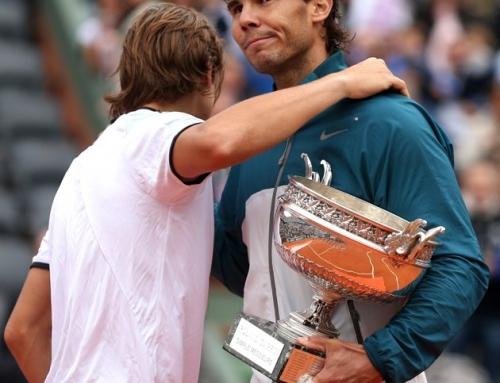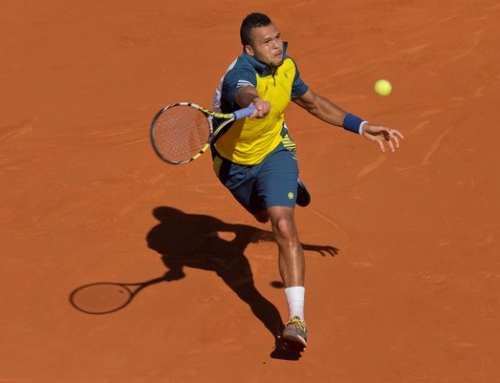 Back in the 1970s and 1980s, the top 3 women players were practically guaranteed smooth sailing until at least the quarterfinals. Players like Martina Navratilova, Chris Evert, and Steffi Graf would lose a game or two in early rounds when women could either not keep up with the consistency or the power or these top pros. Even players ranked 10 in the world or even 5 were sometimes made to look silly by the very best.
Back in the 1970s and 1980s, the top 3 women players were practically guaranteed smooth sailing until at least the quarterfinals. Players like Martina Navratilova, Chris Evert, and Steffi Graf would lose a game or two in early rounds when women could either not keep up with the consistency or the power or these top pros. Even players ranked 10 in the world or even 5 were sometimes made to look silly by the very best.
The men’s game was never quite like that because the men had, if nothing else, power. At any point in time, a guy could get hot, and hit a big shot. Maybe it wasn’t a winner in those days, but it was good enough.
So it comes, in a way, as a surprise that a male player who doesn’t play a huge power game, but has decent power can beat a player ranked 6 in the world dropping only 5 games. Rafael Nadal has long been acknowledged as the king of clay. One way that could happen is by beating players in close matches where your ability to hit one more shot than your opponent at the key moments becomes the tipping point. But the more realistic way is to be a heavyweight amongst lightweights.
On clay, Rafa’s topspin shots kick up higher, serves and groundies are a bit slower, and Rafa’s considerable speed allows him to get to shots that few others get to and at times blast those shots. Just when you think you’ve put Rafa on defense, he pulls out an amazing shot and you’re left flabbergasted.
Rafa has received many accolades. He fights for every point. But so does Lleyton Hewitt. So does David Ferrer. Fighting for every point doesn’t matter if you lack the skill to hit the shot when needed. Rafa gets to so many shots, and in contorted positions, hits such amazing passes that one scarcely believes it’s physically possible to do what he does. In 2010, Rafa was struggling with his game. He had not won a tournament since Rome in 2009. He lost to Federer in the finals of Madrid, then the upset shock loss to Soderling in the French, then skipped Wimbledon, and a shaky hardcourt season, got thumped by del Potro at the US Open. The losses, albeit in late rounds, kept piling up until he reached Monte Carlo where the return to clay rejuvenated his game.
At that event, he played Verdasco in the finals. At one point, Verdasco hits a wide angled volley with pace. Under normal circumstances–and this means, against any other player in the world, this would be a point for Verdasco. Nadal not only chases it down, but passes Verdasco. Nadal plays so many shots where he’s skidding and bending to the side, yet zinging those shots that one wonders how Nadal ever loses, except that sometimes a powerful serve mixed with powerful groundies mixed with Rafa off his game can produce losses.
Rafa, more than any other player, knows how to peak for an event. For Rafa, that peak period starts at Monte Carlo at the start of the clay season and ends at Wimbledon. Every year, for these two months, Rafa tries to be at the top of his game. Sometimes the price is poor play at the US Open and events afterwards.
This year, Rafa has shown a kind of dominance that he hasn’t shown since 2008 when he won the French Open in straight sets, then went to win Wimbledon, and take the Olympics to boot.
Rafa has yet to drop a set. David Ferrer is kinda Rafa Nadal light. He lacks huge shots to really push Rafa, but his shots are certainly more powerful and accurate than Lleyton Hewitt which is why Ferrer is number 6 (and really should be number 5) while Hewitt is off the radar, but consider players like Berdych, Gonzalez (who has retired), and Soderling (who is nearing a year since he last played on tour). The hardest hitters on Earth can’t hit through Rafa. That’s because Rafa is an expert at producing spin.
No other player hits with the spin Rafa does. This means, when he’s in trouble, he’ll loft the ball 10 feet in the air or more to buy himself time. And for Rafa, he only needs a sliver of time to work because he’s among the fastest players on tour, if not the fastest. Furthermore, Rafa doesn’t have to be in a quality, balanced position to hit a good shot. Djokovic, for example, relies on his balance far more than Rafa. Indeed, in today’s match which was delayed by rain, Rafa managed to hit a powerful, accurate shot even as he was falling down. This is how much Rafa’s laser-like concentration helps him even when everyone else would chalk up a fall to bad luck.
Ferrer had pushed Rafa several times on clay. In Barcelona, Ferrer was the better player in the first set, but couldn’t muster a break, then played a poor tiebreak. He did nearly as well in the second set despite a break early on. In Rome, Ferrer again played Rafa tough in the first set which he lost 7-5, only to get blanked in the second set, 6-0.
Perhaps that was a portent of things to come because 5 games was all he could muster against Rafa.
In the other semifinal, which is beginning to look like the challenge for second place, Djokovic has taken the first two sets, 6-4, 7-5. Federer had a break in the second set, but apparently couldn’t consolidate. Djokovic, for his part, looked much better in completing his match against Tsonga despite being pushed to 5 sets and may be nearing the kind of form that would give a glimmer of hope that he could keep up with Rafa in the finals. Should he beat Federer, it will be his first French Open final, and then it will be a contest of which record will be achieved.
For Rafa, he’s looking to be the champ of Roland Garros and win the titles 7 times. Currently, he and Borg hold 6 titles each. For Djokovic, he’s looking to complete the career Slam and also hold four consecutive Slam titles. Right now, he’s the best prospect to beat Rafa on clay, but it looks overwhelming. He’ll need the kind of iron resolve that took him to the Australian Open title and he needs Rafa to falter some too.
One thing for sure, someone is making history on Sunday.




![[French Open] The tactics of the Djokovic-Nadal semifinals](https://www.essentialtennis.com/wp-content/uploads/2013/06/20130607nole-500x383.jpg)
![[French Open, SF] David Ferrer defeats Tsonga in straight sets to reach first Slam final](https://www.essentialtennis.com/wp-content/uploads/2013/06/20130607ferrer-500x383.jpg)
![[French Open, SF] Nadal escapes epic 5-setter with win over Djokovic, to compete for 8th title](https://www.essentialtennis.com/wp-content/uploads/2013/06/20130607rafa-500x383.jpg)
